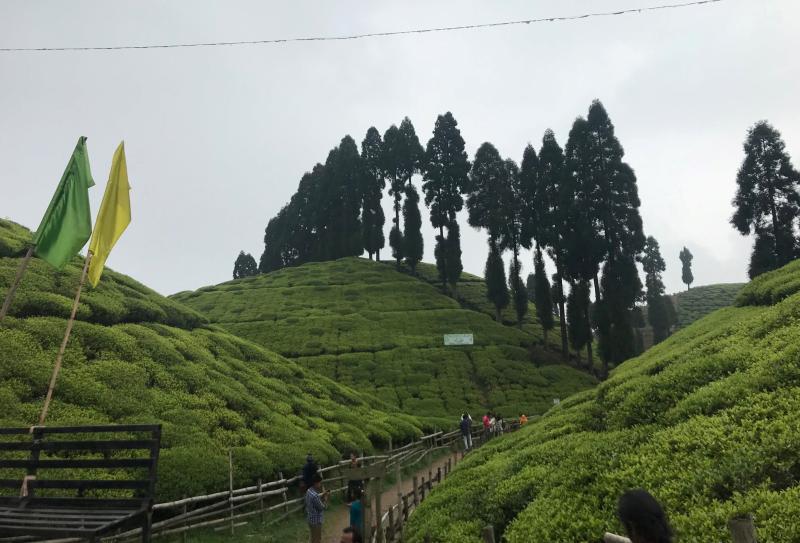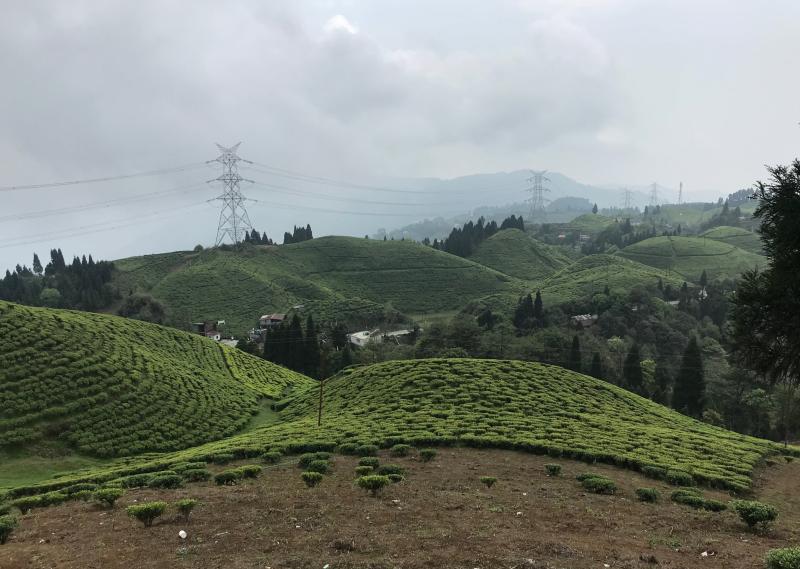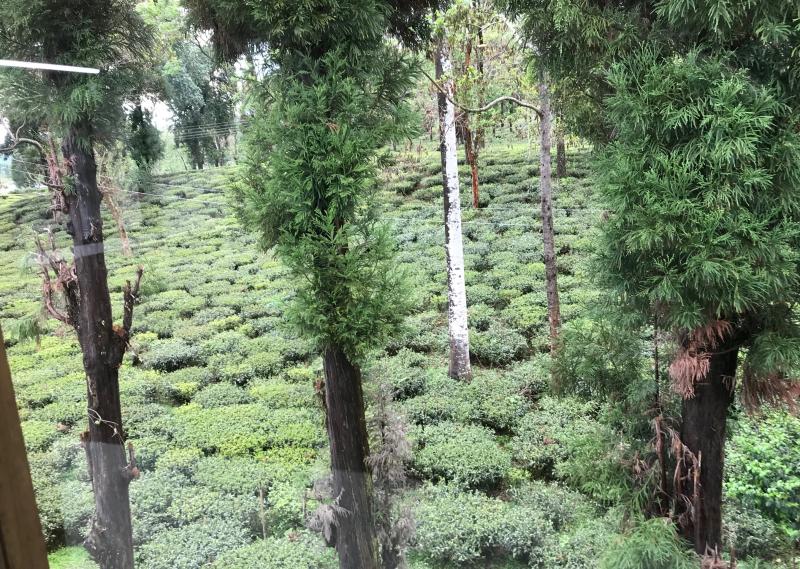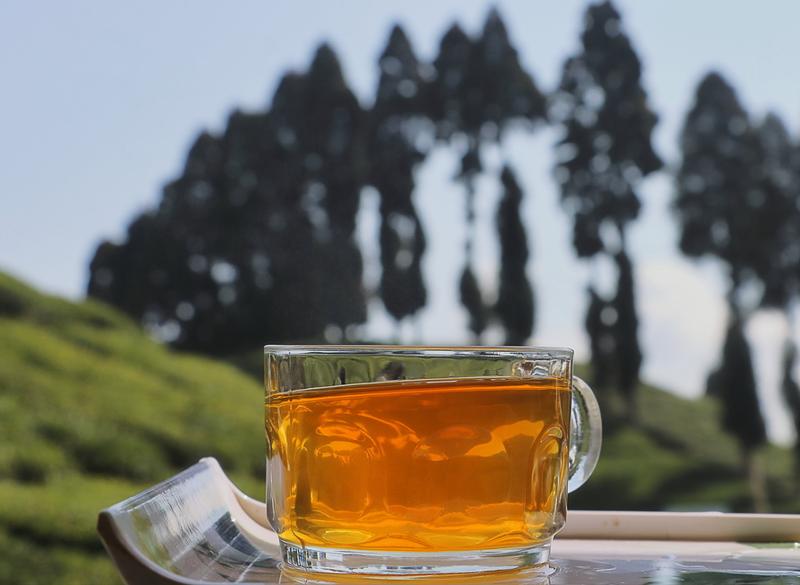Despite labor issues and the COVID-19 pandemic, the most persistently significant upheaval in tea production in recent years has stemmed from the climate crisis, affecting the planet in general but putting particular stress on fragile environments, such as Darjeeling.
The climate crisis was identified as the most significant challenge at the Bengal Chamber of Commerce & Industry (BCCI) Tea Conclave, which took place in Kolkata, India, on Aug. 17.
At the event, it was noted that the United Nations working Group on Climate Change of the Food and Agriculture Organization anticipates that that problems will only accelerate in the coming years, hampering tea harvests further.
The optics in the media illustrate a picture in which Darjeeling planters are barely resisting in a losing cause. Indeed, some have given up. Others are fighting to keep their estates viable as erratic weather conditions from climate change threaten their future.
Having observed firsthand the effects of such changes and recognizing how serious they are, certain planters have recently been developing and introducing management strategies to mitigate the effects of the crisis and protect their treasured harvests. They are lessons that apply to gardens in other areas around the world, as they struggle with similar issues. Indeed, the tea planters in Darjeeling could serve as a model for all farm sites.

Setting the Stage
For centuries, Darjeeling’s climate has been highly stable. And after tea has been planted in these fertile hills, there are four distinct harvests called flushes, each having different flavor characteristics and catering to different segments of the tea market.
Winter dormancy with light rain sustained the plants during off-season and prepared the nutrients to transfer to the leaves, once the plants started to bloom. Leaves would appear as early as February but generally in March and April. This spring harvest is known as “first flush.” These leaves are fine and delicate in character, and the brew gives off a flowery aroma with little or no body. Light in aspect and subtle in flavor, it comes in very high demand and commands premium prices. Sunlight interspersed with periodic rain not only helps the plants grow but also contributes to the flavor sets exhibited by the plants.
In 2023, there was no rain during this important period, and Darjeeling experienced yet another year of drought. The effect of the lack of rain – particularly in mid to low elevation gardens – was profound, sending the plants into a sterile mode called “banji,” in which the growth is too quick.
Instead of getting the desirable two leaves and a bud, only large leaves are produced either with no bud or with a dormant bud, which tends to be flavorless. Banji tea is generally removed from quality tea during the sorting process. However, when most of the crop becomes banji due to overabundance of sunlight and not enough moisture, coaxing the bud to open, much of the harvest becomes ruined. The tea tastes flat and lacks the aroma that is so sought after during first flush.Normally, sunlight followed by light rain is the weather profile of the summer harvest, called “second flush.” This growth of leaves is more mature in character and contains stronger flavor notes – not as much aroma – but more taste, which in some instances is known as muscatel, a sweet musk type flavor that cannot be replicated in other growing regions or during other seasons. But this year, second flush was bombarded by early monsoon type rain halfway through the growing season. Without enough sunlight, the second flush plants do not grow to maturity and the flavor stays locked in the stem, unable to come up to the leaves. The result again is a high yield of flavorless tea.
Monsoon flush teas have generally been unaffected, but the autumn flush that follows the monsoon suffers due to the higher-than-normal temperature that follows. Typically, some sunlight and light warmth revitalizes the plants and gives them aromatic flavor points, as well as body, so autumn flush is well sought after. But, again, when it’s too hot, the growth is too big and banji appears again.
The excess heat draws pests that normally don’t invade Darjeeling plants, and those which grow in non-organic (conventional) gardens, in which chemicals are used, suffer the most. Organic gardens have plants hearty enough to sustain the pest onslaught. In addition, the ecosystem in organic and biodynamic gardens tend to solve the problem with predators feeding off of the pests. But, in gardens where pesticides are sprayed, the predators are also killed. It isn’t long before the pests develop immunity to the pesticides and attack again during the next season, prompting use of harsher chemicals. This cycle is very damaging for the tea, as it doesn’t solve the pest problem and the flavor of tea is affected by chemicals – so too are export prospects.

A Look at Seven Mitigation Strategies for Climate Change in the Tea Industry:
1. Shade Trees
During the time of the British, they used to plant shade trees alongside Darjeeling bushes to keep them from getting too hot in the summer days and too cold at night. Unwittingly, they’d set up natural carbon sinks around the bushes, which soaked up harmful greenhouse gases and prevented them from forming a warming microclimate around the bushes.
According to Pranab Mukhia, garden manager at Goodricke Group Limited’s Thurbo Garden (a second generation tea garden manager), when Indians took over the plantation, these trees were cut down. Workers had been promised firewood as part of their compensation packages, and so cost-conscious garden managers then not knowledgeable about what was known as global warming, felt, “If I cut down the shade trees, I’ll have a free source of firewood for the workers,” says Mukhia. This deforestation has laid the gardens bare of trees that would protect the garden against excessive sunlight and heat.
Also, the damage from pests, such as the red spider, is more pronounced without the protection of shade trees – the cooling canopy acting as a deterrent to these vermin.
Where it isn’t feasible to plant shade trees directly into the area where tea bushes grow, in surrounding areas the planting of such trees form what’s called a “shelter belt,” in which a microclimate is developed by the circumferential shelter trees. They not only keep the belted area cooler than those exposed to the sun, but they also act as windbreakers and hail barriers. Wind and hail in Darjeeling, particularly during storms, can be very damaging to tea plants.
Therefore, afforestation and replanting of shade trees is essential to keeping the excess heat out of the tea gardens. Some Goodricke gardens – particularly mid-elevation gardens like Castleton – are again planting shade trees. It’ll be a long-term process but, ultimately, senior management at Goodricke recognizes that without taking a long-range view of managing the gardens, they won’t be viable in a few years.
2. Reducing the Carbon Footprint
In the early 2000s, all Chamong Tea Group gardens (13 organic gardens in Darjeeling) switched from wood and coal fired furnaces to zero emission LPG furnaces (liquified petroleum gas), making a dramatic impact on the carbon footprint of the factories.
This struck Chamong’s owner, Ashok Lohia, as not quite enough.
As mentioned earlier, garden owners made a deal with workers to provide them with firewood, but in 2012, all of that changed at Chamong gardens. With reports that workers were getting sick, and the tea was starting to get a smokey characteristic to it, Lohia replaced firewood with gas connections to villagers’ homes. The cost of gas is expensive, so Lohia offered subsidies in the form of cash to villagers to make the transition from burning wood to using gas cost neutral. The air was palpably more breathable, and buyers could tell the difference in terms of the freshness of the teas. The wood stayed in the trees to give shade, and fallen branches as well as other tea droppings were used as compost.
Lohia wishes he could take credit for doing the right thing environmentally for the right reasons, but he is a realist. “I wasn’t being altruistic,” he said. “I’m a businessman and activities giving rise to GHG emissions (greenhouse gases) were hurting my business and workforce, so I was compelled to apply green practices. That it is helping to combat climate change in some small way is an ancillary benefit.” He can be lauded for his honesty and simplicity in not acting like some kind of hero. He did the right thing for his garden, regardless of his motivation, and this has positively impacted his green footprint dramatically.
The fact is that, while countering climate change takes investment – it is just that – an investment, that in the long run will pay off economically for the garden. Owners just need to be visionary enough to see their future benefit and make it happen. It’s fortunate that the largest producer of organic teas in Darjeeling has had that vision and made it happen.
One side note to this is that Lohia is now in the process of converting all of his Assam factories to solar power and providing rooftop solar power for the villages. He said the central government and government of Assam has provided incentives – and he is taking full advantage. Soon his Assam gardens will be zero-emission gardens.
In Darjeeling, not all garden owners have the deep pockets to make green investments. Hence, at the BCCI Conclave, keynote speaker on the future of Darjeeling, Anshuman Kanoria, owner of the garden Goomti Estate and chairman of the Indian Tea Exporters’ Association, while identifying climate change as Darjeeling’s greatest challenge, said, “A one-time injection of cash is needed by the government to Darjeeling gardens, so they can take the steps needed to combat this great challenge of climate change.” At the state level, Assam, Bihar and southern states in India are offering climate incentives, but the state of West Bengal has offered nothing to Darjeeling to date. Hence, Darjeeling planters must look to the central government for relief. The Indian Tea Association made a similar request for relief funds in March, 2022, which thus far gone unanswered by the Indian Commerce Ministry.
Like Lohia, Kanoria has also converted all firewood combustion to non-polluting sources by giving connections to villagers and offering cash subsidies to buy whatever alternative fuel the villagers want. He did this immediately after buying the garden three years ago. But it wasn’t an easy process getting the villagers to accept the alternate fuel. “There was suspicion and resistance,” says Kanoria. “You know, there is a word in Darjeeling called ‘Dastoor,’ which translates to the phrase, ‘Whatever has been happening must continue.’ We had to overcome this ‘Dastoor’ inertia, to convince people that changing fuel sources had the best interests of the plantation in mind – and therefore, their benefit at heart.”
Kanoria insists, though, that what they’ve been doing isn’t enough to alter the trend of a global problem. He altered his plucking protocols to ensure that his second flush maintained quality during the hot summer and premature monsoon. “But I had to give up yield in favor of flavor. It was the only way I could maintain the reputation of the garden, and we’ve gotten some positive feedback in regard to our second flush harvest.”
However, without governments taking climate change more seriously, the situation – as the U.N. pointed out – will get worse. “What can we do about emissions from Darjeeling town that are carried by wind to our gardens?” he said. “We have no authority over whether EVs [electric vehicles] are mandated for use in town and diesel vehicles only earmarked for climbing hills. This is the purview of government.”

3. Dealing with Drought
Much has been written about Toklai Tea Research Institute’s development of climate resistant clones. There are 33 to be exact. However, how each will perform in vivo (in the real living world, as scientists like to say), is a question yet to be answered. Also, many of these clones lack the flavor that planters say they need to sell on the market.
OKAYTI garden has found success with Clone no. P312. It’s a drought resistant clone with flavor characteristics typical of the garden. “We’ve earmarked a large swath of uncultivated land at high elevation to plant around 40,000 drought resistant clones,” said garden manager Pankaj Chobey. “It’s going to be a difficult fight, combating climate change but human ingenuity must be used to save the gardens.”
For those who aren’t planting the clones, there is irrigation. Previously unheard of in Darjeeling, several gardens, including Gopaldhara, Rohini, OKAYTI, various Goodricke Gardens and Jungpana, have been using irrigation to keep the plants from turning banji during drought periods. “We’re not watering the plants for growth,” said co-owner, Rishis Saria of Gopaldhara and Rohini Gardens. “This is just to preserve the plants in their proper growing stage during first flush.”
Goomti does some irrigation. “We have water shortages in our garden. Still, we try limited irrigation to keep our first flush from getting ruined,” said Kanoria.
Lohia’s is fortunate in that several of his gardens have access to water. Jungpana is flush with water, so they have no irrigation issues.
In gardens in which access to water poses a challenge, rainwater harvesting becomes critical to irrigation.
4. Water Management
During heavy rains, the tea plants get water-logged and can’t produce quality leaf, so drainage is key to keeping this form occurring. If one goes to Gopaldhara, one will see drainage ditches having been dug for just such a purpose. In general, all gardens have emulated this.
But water needs to be held at the root when it isn’t raining. Accomplishing this involves keeping the gardens as organic as possible. When chemical fertilizers and pesticides are used, it depletes the water holding capacity of the soil. So, many gardens are now using organic mulch, be it cow dung or tree droppings or pruning litter (the organic matter that comes from pruning) to spread around the roots of the plants to hold nutrient-rich water at the level of the root. It’s one of the easiest ways to recycle crop residues, and only costs the labor required to chop up and spread the mulch.
Mulching is especially important after the monsoons, as the dry spell that occurs in Autumn through winter can be countered by having mulch hold the moisture within the root system of the plants. Mulching reduces evaporation, lowers the impact of surface run-off (a problem in a hilly region such as Darjeeling, in which the angle of soil causes water to spill off) and counters soil erosion.
Moreover, according to the Food and Agriculture Organization of the United Nations, tea waste compost can be used at a rate of one to two metric tonnes/ha/year to increase the fertility of the land. Compost helps water to infiltrate into the soil rather than running off the surface, and it protects against wind erosion as the humus, which is rich dark soil resulting from the decomposition of plant and animal matter, in the compost helps to bind soil particles together.
In tea, compost can be prepared from jungle matter, weeds and grasses – really any green crop.
The excessive rain that ruined half of the second flush crop in 2023 didn’t do so in one garden that chose not to be named, as they were able to process much of the moist leave through a new withering technology that uses desiccated air to remove moisture. The withering process occurs within five to six degrees Fahrenheit above room temperature, avoiding the use of high heat – but pulling the moisture out of the air and the leaves by using, effectively, dehumidifiers and applying withering for a longer period, helped them save their second flush harvest.
It's technologies like these that must be implemented across the board, now, to deal with the erratic rains and associated lack of sun on the processing side to keep Darjeeling tea tasting like Darjeeling tea. Other gardens managers will be tempted to over-fire, leading to smokiness and a burnt character that runs counter to the desired sweetness of muscatel in second flush.

5. Back to Basics
When the British brought tea from China, the plant they used was China Bush (literally a bush obtained from China). Cuttings and clones have been made from these plants and also the Assamica plant in gardens to increase yield. However, the China plant has what’s called a taproot, which is a long deep root that siphons water from deep into the soil for use by the plant. Clones on the other hand grow lateral roots, which spread out from the trunk of the plant. These are not able to absorb water as well as the taproot plants.
So, Goodricke is collecting their Chinery seeds and replanting them where there is space to ensure that they have a higher proportion of taproot plants. This will be a five to seven year project before viability.
Moreover, its overuse of clones that is causing the Nepal and Darjeeling teas to be virtually indistinguishable, as Nepal tea is made from Darjeeling cuttings. However, the China bush plants, with their deep-rooted foundation, are able to grab nutrients in such a way as to create far more complexity and strong aroma in their flavor profile. China bush, hence, will always taste different than Nepal tea made from cuttings. So, planting of more Chinery may help solve the problem of Nepal tea being sold as Darjeeling, which has long been a complaint of producers.
“If you do a blind taste test of China vs. cuttings, you’ll find that most tea experts almost without fail will prefer the China bush to clones,” said Mukhia.
Gopaldhara tea estate is planting China bushes at a rate of approximately 100,000 to 150,000 plants per year in the hopes that in five to seven years, their garden will be totally revitalized. This would create a huge carbon sink for the garden.
6. Crop Diversification
The British used to plant orchards near tea plantations. It is said that the wafting of orange aroma in the added to the fruitiness of the harvest. Whether that’s true or not, planting orchards or other greenery in unproductive land not only offers flavoring ingredients for flavored teas and a source of income for workers but also acts as a carbon sink.
A diversity of crops keeps the soil healthy and also helps create a cooler microclimate around the tea bushes to prevent overheating of the bushes.
7. Ecotourism
Currently, the West Bengal government has opened Darjeeling to tea tourism, permitting widespread development that could be detrimental to the gardens. Indeed, activities such as bonfires, in which smoke exposure affects the flavor of the leaves fire attracting insects can have serious negative impacts on the tea plants. Also, unrestricted human entrance into the tea plantations leaves plastic bags, bottles, cigarette buts and other kinds of garbage, which is a cost to the garden to clean up. These can’t just be left in place because of the chemical seepage from these non-biodegradables. The nearest recycling centers to Darjeeling District are situated in Darjeeling town and Kurseong. So for places like Mirik, which are at some distance from both towns, collection and transport of this garbage becomes a considerable expense.
Garbage decreases the capability of greenery from being a carbon sink, increasing the effects of climate change. Regular bonfires at night run contrary to the natural coolness of the forest that is needed by tea plants, and the introduction of carbon monoxide fumes from the burning of wood (or coal combined with the natural carbon dioxide given off by plants) can be toxic for the tea plants. So, this form of “fun” should be stopped. There are some tea gardens that have reversed their policy on bonfires because it not only is bad for the tea plants but encourages behavior that is detrimental to the peaceful environment of the area.
Jungpana is in the process of establishing nature trails. With its seven waterbodies (streams and waterfalls) it gives tourists much to do that is eco-friendly – this too without staying in a treehouse (Jungpana resort, called Mayfair Manor, is a luxury colonial style property).
The Nirvana Retreat, located close to Castleton and Malabari Gardens, organizes nature walks and utilizes herbs in their making flavored teas in their teahouse, giving tourists the opportunity to value the ambient environment and take the message back to the cities that this needs to be preserved and protected.
Darjeeling: On the Frontline of Climate Change in the Tea Industry
So, climate change isn’t just doom and gloom in Darjeeling. There are people with vast experience farming the land with top researchers backing them up, who are on the frontlines of the fight against climate change.
The garden owners just need to share their knowledge and learn from one another rather than squabble over who is adulterating their tea with Nepal leaf.Darjeeling planters and the workers know well that the ultimate tea producer is “Mother Nature,” and for their part have made efforts to try keep her healthy, so pollution doesn’t continue to cause the sickness that is the climate crisis.
A wider application of the aforementioned strategies – along with education, promotion and lobbying the government – may all have some impact in healing Darjeeling’s climate ailment.
In the final analysis, it is far too premature to write Darjeeling’s obituary; the place still has a lot of life left in it and people are working to keep that life long lasting.
SB Veda is the pen name for Sujoy Bhattacharyya, who is a British/Canadian writer based in Kolkata. Born in London and raised in the U.K. and Canada, the award-winning writer and editor’s work has also been published in The Independent, The Guardian, the Ottawa Citizen, The Global Calcuttan and Pragati International. He has a longstanding connection to Darjeeling, where he tries to visit once a year, and he’s currently working on a book about a Darjeeling tea garden, which is expected release in 2023.
Don’t Miss the Weekly World Tea News eNewsletter! Get your free subscription, if you’re not already subscribed, by clicking here.
Plan to Attend or Participate in World Tea Expo, March 18-20, 2024
To learn about other key developments, trends, issues, hot topics and products within the global tea community, plan to attend World Tea Expo, March 18-20, 2024 in Las Vegas, co-located with Bar & Restaurant Expo. Visit WorldTeaExpo.com.
To book your sponsorship or exhibit space at the World Tea Conference + Expo, or to enquire about advertising and sponsorship opportunities at World Tea News, contact:
Ellainy Karaboitis-Christopoulos
Business Development Manager, Questex
Phone: +1-212-895-8493
Email: [email protected]
Also, be sure to stay connected with World Tea Expo on social media for details and insights about the event. Follow us on Twitter, Facebook, Instagram and LinkedIn.
